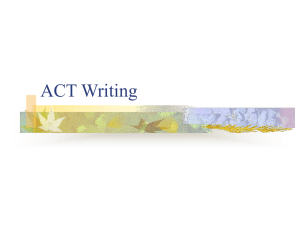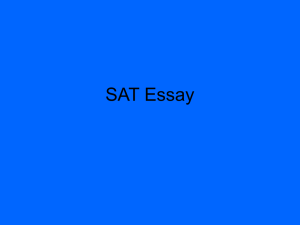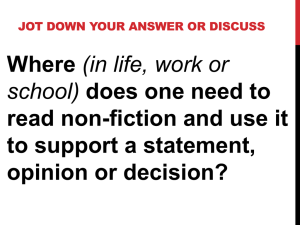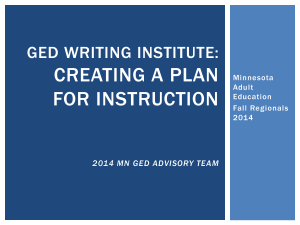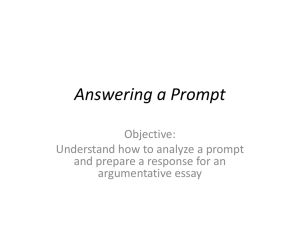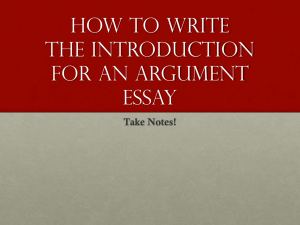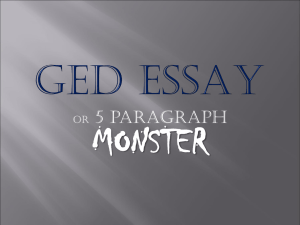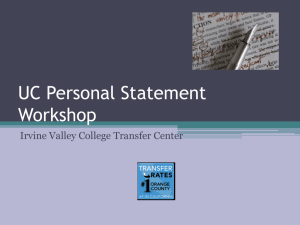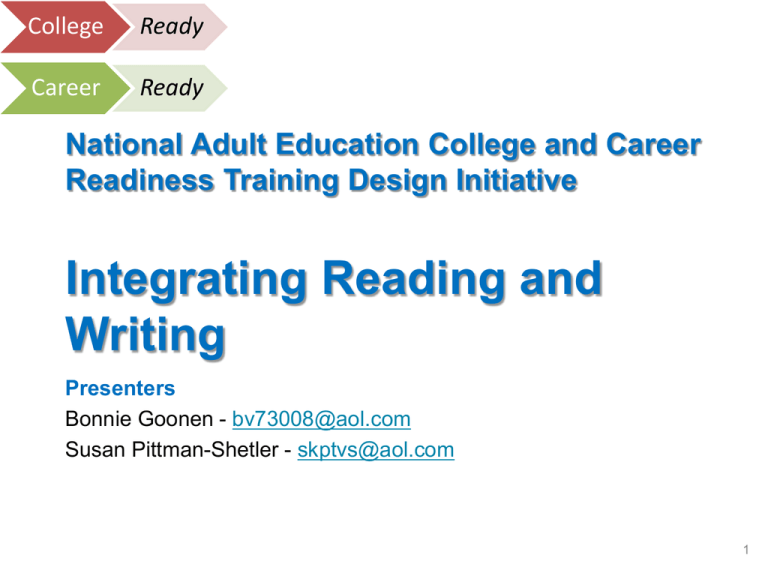
College
Ready
Career
Ready
National Adult Education College and Career
Readiness Training Design Initiative
Integrating Reading and
Writing
Presenters
Bonnie Goonen - bv73008@aol.com
Susan Pittman-Shetler - skptvs@aol.com
1
Focus of the Train-the-Trainer
Session – Part 2
• Review college and career readiness standards
for English Language Arts content and practices
• Explore research-based strategies for integrating
reading and writing skills
• Review evidence-based scoring rubric and
sample anchor papers
• Explore resources for leaders to use to enhance
learning with different audiences
2
"WRITING TODAY IS NOT A FRILL
FOR THE FEW, BUT AN ESSENTIAL
SKILL FOR THE MANY."
THE NEGLECTED "R": THE NEED FOR A WRITING REVOLUTION
3
Driving Questions
• How can I support my teachers’
understanding of the CCR/ELA
Standards?
• In particular, where can I go to find
tasks, video, and other resources to
help teachers implement the
CCR/ELA Standards in their
classrooms?
4
What Are Standards?
• Standards for CCR ELA/Literacy Content
– Reading Anchor Standards
– Writing Anchor Standards
– Speaking and Listening Anchor Standards
– Language Anchor Standards
5
Standards-Driven Curriculum
Standards/
Practices
Student
Achievement
Classroom
Instruction
6
Key Shifts in the Standards
Shift 1: Complexity
• Regular practice with complex text and its academic
language
Shift 2: Evidence
• Reading, writing, and speaking grounded in evidence
from text, both literary and informational
Shift 3: Knowledge
• Building knowledge through content-rich nonfiction
7
Complexity
Shift 1 – Complexity: Regular practice with complex text
and its academic language
• Complexity of text that students can read is the
greatest predictor of success
• There is a four grade level gap between secondary
and college/career level text
• Shift from how students read to complexity of texts
that are read
• Focus needed on addressing academic vocabulary
of students
8
Complexity
Shift 1 – Complexity: Regular practice with complex text
and its academic language
9
Evidence
Shift 2 – Evidence: Reading, writing, and speaking
grounded in evidence from text, both literary and
informational
• Priority placed on textual evidence based on
national assessment data
• Focus is on students’ ability to cite evidence from
text in order to present
• Careful analyses
• Well-defended claims
• Clear information
10
Knowledge
Shift 3 – Knowledge: Building knowledge through
content-rich nonfiction
• Focus not limited to English language arts, but also
literacy across the disciplines of
• Science
• Social studies
• Technical subjects
• Focus shifts to nonfiction text that constitutes the
majority of what people read in college and the
workplace
11
Design and Organization
English Language Arts/Literacy Standards
• Separated into four strands: Reading, Writing, Speaking and
Listening, and Language
• Strands are headed by CCR Anchor Standards
• Each anchor standard identifies broad college and career
readiness skills
• Each anchor standard corresponds to a level-specific standard
• Standards are bundled into five grade-level groups:
– A (K-1), B(2-3), C (4-5), D(6-8), E (9-12)
– Reflect adult education levels of learning
Example: RI.4.3 = Reading Informational Text, Grade 4, Standard 3
12
Design and Organization
Writing Standards
Anchor
LevelSpecific
13
Design and Organization
14
Manageable and Essential
• CCR Standards for Adult Education consists of a
manageable set of standards essential for college and
career readiness
• Consistency between K-12 and adult education
systems
• Opportunity to create common tools and materials to
support implementation
• Opportunity to prepare students for new assessment
models (e.g., GED® test, PARC, and Smarter Balance)
CCR Standards for Adult Education, 2013
15
Alignment to CCSS in ELA/Literacy
2014 GED® test
Fully aligned to CCSS
as well as college and
career readiness
standards developed by
Texas and Virginia
HiSET™
Phase I reflects
substantial alignment
with CCSS in English
Language Arts and
Mathematics
Phase 2 will reflect
greater alignment with
CCSS
TASC
2014 -2016, each TASC
subtest will align more
tightly with the CCSS
Transition begins in
2014 with multiplechoice items in Reading
and a writing prompt in
2016.
Constructed responses
will include constructedresponse and
technology enhance
items.
16
English Language Arts/Literacy
New Realities
17
What is at stake?
“My view is that good writing is a sign of
good thinking. Writing that is persuasive,
logical, and orderly is impressive. Writing
that’s not careful can be a signal of
unclear thinking.”
“Writing is integral in nearly every job. It’s
really not a promotion issue since you’d
never get to the point of promotion
without good communications skills. You
can’t move up without writing skills.”
18
Overview of Content
2014 GED® test
Integrated reading and
writing assessment
75% - nonfiction
25% - fiction
Constructed responses
• Reasoning through
Language Arts
• Social Studies
• Science
Enhanced technology
items
HiSET™
TASC
Two tests
• Language Arts – Reading
• 40% - literary
• 60% - nonfiction
• Language Arts – Writing
Contextualized
editing/revising
• Essay
Two tests
• Reading
• 30% - literature
• 70% informational
text
• 10%-15%
derived from
vocabulary items
• Multiple choice items
• Essay question
• Language Arts,
Writing
• Multiple choice
• Prompt
19
What’s new in the Reading content
domain?
• Analyze how individuals, events, and ideas develop
and interact.
• Analyze the structure of texts.
• Determine the author’s purpose or point of view.
• Delineate and evaluate the argument and specific
claims in a text.
• Analyze how two or more texts address similar themes
or topics.
20
What’s new in the Language
content domain?
• Complete item types that simulate real-life
editing tasks
• Edit to eliminate non-standard or informal usage
• Develop an argument and support ideas with textbased evidence
• Strategically apply awareness of audience and
purpose of the task
21
What’s new in the Writing domain?
Constructed Responses
• Provide real-world opportunity for test-takers to
develop an argument and support ideas with textbased evidence
• Integrate reading and writing skills
• Scored using a multi-dimensional rubric
• Can be an extended response or a short answer
22
Then
2002 GED® Essay Prompt
What is one important goal you would like to achieve in
the next few years?
In your essay, identify that one goal and explain how
you plan to achieve it. Use your personal observations,
experience, and knowledge to support your essay.
23
Now – 2014 GED® test
24
Now – HiSET™
Copyright © 2013 Educational Testing Service.
25
Now – TASC
Copyright © 2013 CTB/McGraw-Hill Proprietary
26
Holistic Scoring
27
BEGIN WITH
THE END IN MIND!
28
CCR Writing Standards
CCR Anchor 1: Write arguments to support
claims in an analysis of substantive topics or
texts, using valid reasoning and relevant and
sufficient evidence.
• Introduce a claim
• Supply evidence of each claim
• Use words, phrases, and clauses to link
sections Create cohesion
• Establish and maintain formal style and
objective tone
• Attend to the conventions
• Provide a concluding statement that
supports argument presented
29
Scoring based on 2014 GED®
Traits of Writing
30
Trait 1 Rubric Overview
• Argument
– Creation of argument
– Evidence – use of text citations to support created
argument of source text(s)
• Validity
– Assessment of the argument in source text(s)
– Analysis of the issue
• Integration
– Integration of claims, explanations and textual evidence
– Connection of purpose to prompt
31
Trait 2 Rubric Overview
• Ideas
– Development (reasoning)
– Elaboration of ideas
• Progression
– Progression (flow) of ideas
– Connection of details to main ideas
• Organization
– Structured to convey message
– Transitional devices
• Words
– Appropriate word choice
– Advanced vocabulary application
• Awareness
– Demonstrated to audience and purpose
– Form of writing – objective rhetoric and persuasive
32
Trait 3 Rubric Overview
• Conventions – Application of standard English (e.g.,
homonyms/contractions, subject-verb agreement, pronoun
usage, placement of modifiers, capitalization, punctuation)
• Sentence Structure
– Variety
– Clarity
– Fluency (e.g., correct subordination, avoidance of
wordiness, run-on sentences, awkwardness, usage of
transition words, appropriate usage for formal structure
• Errors
– Mechanics and conventions
– Comprehension based on errors
33
Let’s Take a Closer Look
An Analysis of Daylight Savings Time
The article presents arguments from both supporters and
critics of Daylight Saving Time who disagree about the
practice’s impact on energy consumption and safety.
In your response, analyze both positions presented in the
article to determine which one is best supported. Use
relevant and specific evidence from the article to support
your response.
– Materials from GED Testing Service®
34
Reviewing the Anchor Papers
• Read each of the anchor papers
• Identify the following:
– Claim or stance
– Evidence to support claim or stance
– Strengths and weaknesses of each
writing sample
•
•
•
•
Development of ideas and organization
Use of the conventions of standard English
Sentence structure
Errors in mechanics and conventions
35
Trait 1 Rubric Overview
• Argument
– Creation of argument
– Evidence – use of text citations to support created
argument of source text(s)
• Validity
– Assessment of the argument in source text(s)
– Analysis of the issue
• Integration
– Integration of claims, explanations and textual evidence
– Connection of purpose to prompt
36
Trait 1: Creating Arguments and
Using Evidence
•
“In the argument for daylight savings time, it seems that the
pro daylight savings time position has won. The first article
brings up several improvements in the daily lives of
Americans which daylight savings time brings about. The
article then uses studies and large scale research to
support it’s position. In the second article, only smaller scale
studies are used, and the writer uses arguments with no
factual basis to support an anti-daylight savings position.
•
In the first article, historical facts are supplied to explain
why daylight savings time was created – to save energy
during the first world war – and the way it has evolved over
the years from a state decision to a national one. . .”
Argument
Supporting
Evidence
37
Trait 2 Rubric Overview
• Ideas
– Development (reasoning)
– Elaboration of ideas
• Progression
– Progression (flow) of ideas
– Connection of details to main ideas
• Organization
– Structured to convey message
– Transitional devices
• Words
– Appropriate word choice
– Advanced vocabulary application
• Awareness
– Demonstrated to audience and purpose
– Form of writing – objective rhetoric and persuasive
38
Trait 2: Development of Ideas and
Organizational Structure
“. . . In the first article, historical facts are supplied to explain
why . . .”
“. . . The second article cites this technology, which is much
more prevalent now than in the 1970s and certainly more than
during the inception of DST . . .”
“. . . The next topic, which is cited by both arguments, is driver
and pedestrian safety . . .”
“. . . The second article, however, did not read the facts
carefully, because the facts they cite . . .”
39
Trait 3 Rubric Overview
• Conventions – Application of standard English (e.g.,
homonyms/contractions, subject-verb agreement, pronoun
usage, placement of modifiers, capitalization, punctuation)
• Sentence Structure
– Variety
– Clarity
– Fluency (e.g., correct subordination, avoidance of
wordiness, run-on sentences, awkwardness, usage of
transition words, appropriate usage for formal structure
• Errors
– Mechanics and conventions
– Comprehension based on errors
40
Trait 3: Clarity and Command of Standard
English Conventions
Use of
“. . . Opponents counter this claim, stating
other results from different studies nullify this
finding. According to the article, “a study in
California indicated that DST had little or no
effect on energy consumption that year.” In
another study done in Indiana, it showed that
“residents of that state spend $8.6 million
more each year for energy, and air pollution
increased aft he state switched to DST.” It is
hypothesized that these jumps in energy and
pollution are due to “increased use of air
conditioning as a result of maximizing daylight
hours.” Clearly this counters the argument that
Daylight Savings Time is a cost effective
measure. Energy efficiency isn’t the only
aspect of DST that can be disproven. . .”
standard
English
Sentence
variety
Clarity of
thoughts
Few errors
41
2014 GED® SS Extended Response Rubric
42
Sample Social Studies Prompt
In your response, develop an argument about
how the author's position in her letter reflects the
enduring issue expressed in the excerpt from
Thomas Jefferson. Incorporate relevant and
specific evidence from the excerpt and the letter
as well as your own knowledge of the enduring
issue and the circumstances surrounding the
case to support your analysis.
43
Short Answers in Science
Science Test MC Item
Identify which step (out of four
listed) would produce a particular
outcome in a scientific process?
Science Test SA Item
Design an experiment to test the
hypothesis (given in the stimulus).
Be sure to include descriptions of
your data collection process and
data analysis in your response.
Advantages: SA items allow assessment of a higher level of cognitive
complexity because they require test-takers to express a response in
their own words.
Tasks that appear in short answer items more like problems test-takers
encounter in their daily lives.
44
Short Answer Scoring Rubric
“Because each item will have its own rules
for scoring, scoring guides will be developed
alongside the item itself.”
GEDTS® Assessment Guide for Educators 3.3.
45
A Review of the Research
Evidence-based practices for teaching
writing include . . .
Adapted from the research of Steve Graham and Amy Gillespie,
Vanderbilt University (2011)
46
A Review of the Research
Strategy Instruction
Summarization
Peer Assistance/Collaboration
Setting Product Goals
Word Processing
Sentence Combining
Adapted from the research of Steve Graham and Amy Gillespie,
Vanderbilt University (2011)
47
A Review of the Research
Process Approach
Inquiry
Pre-Writing Activities
Writing as a Tool for Learning
Study of Models
Adapted from the research of Steve Graham and Amy Gillespie,
Vanderbilt University (2011)
48
Don’t Forget That Once Is Not Enough!
When teaching a new strategy
• Activate background knowledge
• Discuss the strategy
• Model the strategy
• Have students memorize the steps for the
strategy
• Support students learning to implement
(scaffolding)
• Establish independent practice to gain
mastery (practice makes perfect)
49
What is sentence combining?
It is the act of making one smoother, more detailed
sentence out of two or more short, choppy
sentences.
It starts with a “kernel” – an irreducible sentence.
• For example:
– The dog ran.
– The story is boring.
50
Benefits of Sentence Combining
• Increases an awareness of writer
motivations and reader responses
• Helps convey different ideas
• Assists in the use of the grammar
in context
• Fosters revision skills
51
A Few Ways to Combine Sentences
• Use a series of words or phrases
• Use compound subjects and/or verbs
• Use a key word (move a word between
sentences)
– I am going to meet the president.
– I will meet him tomorrow.
Tomorrow, I am going to meet the
president.
• Use phrases (prepositional, participle,
infinitive, and appositive phrases)
• Use compound or complex sentences
52
Let’s Combine!
• Meditation can help you relax.
• Meditation is a technique.
• The technique can be learned.
53
Let’s Combine! How about . . .
• Meditation can help you relax.
• Meditation is a technique.
• The technique can be learned.
Meditation, a relaxation technique,
can be learned.
54
Let’s Combine!
• Nina applied for a job.
• Nina needed to earn money.
• Nina is a hard worker.
55
Let’s Combine! How about . . .
• Nina applied for a job.
• Nina needed to earn money.
• Nina is a hard worker.
A diligent employee, Nina applied for
a job to earn additional money.
56
Let’s Combine!
•
•
•
•
A sports car screamed around the corner.
The sports car was red.
It screeched to a stop in front of the doors.
The doors led into the hospital.
57
Let’s Combine! How about . . .
•
•
•
•
A sports car screamed around the corner.
The sports car was red.
It screeched to a stop in front of the doors.
The doors led into the hospital.
The fire-red sports car screamed around the corner and
screeched to a stop in front of the hospital emergency
room.
Screaming around the corner, the fire-red sports car
screeched to a stop in front of the hospital’s emergency
room door.
58
How to Incorporate Sentence
Combining
• Introduce alongside the writing process
• Provide short, frequent sessions
• Organize lessons into
– Teacher modeling
– Support/guided practice
– Independent practice
• Develop evaluative questions
• Use content as exercises
• Make it fun!
59
60
Effective readers use text structure to . . .
• Predict what is to be read
• Comprehend/understand text
• Observe the way the author has
organized the text
• Look for key words and concepts
• Note the different headings and
subheadings
• Notice and interpret graphics
61
Types of Text Structure
• Description
• Sequence and Order
• Compare and Contrast
• Cause and Effect
• Problem and Solution
62
63
Rules of Summarizing
• Attribute sources
• Cite the original source
• Use topic sentences
• Give your audience an idea of main points you want to
make
• Omit excess detail
• Leave out minuscule details; focus on what’s relevant
• Collapse lists
• Condense lists to single descriptive word
• Condense multiple paragraphs to one paragraph
64
Summarizing
British Pass Stamp Act – March 22,1765
Hoping to raise sufficient funds to defend the vast new American territories won from
the French in the Seven Years' War, the British government passes the notorious
Stamp Act in 1765. The legislation levied a direct tax on all materials printed for
commercial and legal use in the colonies, including everything from broadsides and
insurance policies to playing cards and dice.
Though the Stamp Act employed a strategy that was common in England, it stirred a
storm of protest in the colonies. The colonists argued that Parliament could not impose
taxes upon them without their consent. Believing this right to be in peril, the colonists
rioted and intimidated all the stamp agents responsible for enforcing the act into
resignation.
Not ready to put down the rioters with military force, Parliament eventually repealed
the legislation. However, the fracas over the Stamp Act helped plant seeds for a far
larger movement against the British government and the eventual battle for
independence.
65
Somebody-Wanted-But-So
Somebody
Christopher
Columbus
Anne Frank
Wanted
But
To sail to India to buy
He ran into the
He claimed the area
spices
Caribbean Islands
for Spain.
To hide from the
Someone turned her
She died in a
Nazis
in
concentration camp.
Adolf Hitler
To control all of
Europe
The Allies fought
against him
Thomas Edison
To invent the
incandescent light
bulb
His light bulb
blackened (the
Edison effect)
?
British
So
He killed himself
when Germany was
defeated.
It later led to the
electron tube, the
basis of the
electronics industry
?
?
66
Important Ideas
67
Getting the GIST
• Build comprehension and writing skills. (It’s really only
5 Ws and an H)
• Summarize in 20 words or less.
68
69
Brainstorm Time!
Constructed response is . . .
70
What is constructed response?
• Assessment items that ask students
to apply knowledge, skills, and
critical thinking abilities
• Requires students to “construct”
answers without the benefit of any
suggestions or choices.
• Requires students to generate and intertwine
ideas into a response that is directly related to the
text(s)
• Short or extended
71
RLA Extended Response
72
Science Short Answer
73
Social Studies Extended Response
74
Steps for Drafting Constructed
Responses
1. Read the passage and question
2. Unpack the prompt (identify key words)
3. Rewrite the question in your own words and
turn the question into a topic sentence/ thesis
statement
4. Collect relevant details from passage
5. Organize details into a logical order
6. Draft your answer
7. Re-read and edit/revise your answer making
sure all parts of the question are answered
75
Use a Process
Use a step-by-step approach, including
how to:
• unpack a prompt
• set up a claim (thesis statement)
• identify evidence in the to support
the claim
76
Unpacking a Prompt – Do/What?
Explain a key similarity between Truman’s speech and
Roosevelt’s speech. Use evidence from both articles to
support your response.
Type your response in the box. This task may require
approximately 25 minutes to complete.
Copyright © 2013 GED Testing Service
Do
What
Explain
Key similarity between the two speeches
Use
Evidence from both articles
Type
Your response
Take
Approximately 25 minutes
77
Unpacking a Prompt – Do/What?
A person who seems in charge of every situation is sometimes called
a “natural leader.” People often look to such a person to lead them in
projects both great and small.
Select someone you have read about who seems to be a natural
leader. Write an essay in which you describe the person and his or
her accomplishments so vividly that your readers will feel they know
the person.
Do
What
Select
Someone you’ve read about – a natural
leader
Write
Essay
Describe
The person and accomplishments
78
It’s Your Turn - Unpack a GED® Prompt
While Dr. Silverton’s speech outlines the benefits
of cloud seeding, the editorial identifies
drawbacks of this process.
In your response, analyze both the speech and
the editorial to determine which position is best
supported. Use relevant and specific evidence
from both sources to support your response.
Type your response in the box. This task may
require approximately 45 minutes to complete.
79
It’s Your Turn - Unpack a GED® Prompt
While Dr. Silverton’s speech outlines the benefits of cloud seeding, the editorial
identifies drawbacks of this process.
In your response, analyze both the speech and the editorial to determine which
position is best supported. Use relevant and specific evidence from both sources to
support your response.
Type your response in the box. This task may require approximately 45 minutes to
complete.
Copyright © 2013 GED Testing Service
Do
What
Analyze
Speech and editorial
Determine
Best supported position
Use
Relevant/specific evidence from both
Type
Response
Take
45 minutes
80
It’s Your Turn – Unpack a HiSET™ Prompt
Staying physically fit involves practicing habits such as
exercising regularly, eating well and getting enough sleep.
Research has shown that people who are physically fit
perform better in work and school. Your employer is
printing a special newsletter informing employees about
important ways they can practice staying fit.
Write an essay for your employer’s newsletter to persuade
workers to adopt at least one behavior that will improve
their fitness. Think carefully about what reasons will
convince other workers to change their behavior.
Copyright © 2013 Educational Testing Service.
81
It’s Your Turn – Unpack a HiSET™ Prompt
Staying physically fit involves practicing habits such as exercising
regularly, eating well and getting enough sleep. Research has shown
that people who are physically fit perform better in work and school.
Your employer is printing a special newsletter informing employees
about important ways they can practice staying fit.
Write an essay for your employer’s newsletter to persuade workers to
adopt at least one behavior that will improve their fitness. Think
carefully about what reasons will convince other workers to change
their behavior.
Copyright © 2013 Educational Testing Service.
Do
What
Write
Persuasive essay
Think
About reasons that will convince workers
to change their behavior
82
It’s Your Turn – Unpack a TASC Prompt
Write an essay to delineate and explain the qualities of an effective
argument. Base your ideas on the two texts you have read: the excerpt
from Thomas Jefferson’s “Declaration of Independence” and the excerpt
from Frederick Douglass’ speech “What to the Slave is the Fourth of July?
As you plan and write your essay, be sure that you
• Organize and develop your ideas with specific and relevant information
and examples from the two texts
• Use appropriate syntax and transitions to link your ideas
• Choose words precisely to convey your ideas
• Establish and maintain an appropriate style and tone
Copyright © 2013 CTB/McGraw-Hill Proprietary
83
It’s Your Turn – Unpack a TASC Prompt
Write an essay to delineate and explain the qualities of an effective argument. Base your
ideas on the two texts you have read: the excerpt from Thomas Jefferson’s “Declaration
of Independence” and the excerpt from Frederick Douglass’ speech “What to the Slave is
the Fourth of July?
As you plan and write your essay, be sure that you
• Organize and develop your ideas with specific and relevant information and
examples from the two texts
• Use appropriate syntax and transitions to link your ideas
• Choose words precisely to convey your ideas
• Establish and maintain an appropriate style and tone
Copyright © 2013 CTB/McGraw-Hill Proprietary
Do
What
Write
Essay to delineate and explain qualities of argument
Base
Ideas on text read
Organize/develop
Ideas with specific/relevant information and examples
Use
Syntax and transitions
Choose
Words to convey ideas
Establish/maintain
Appropriate style and tone
84
Unpacking a Prompt – Do/What?
In the two autobiographies, the authors describe the challenges
they must overcome to learn essential skills. Compare and
contrast the challenges that each author faces and describe how
each addresses those challenges. Use specific details from the
two passages, Type your answer. This task may require
approximately 45 minutes.
Do
What
Compare and contrast
Challenges each author faces
Describe
How each addressed the challenges
Use
Evidence from both passages
Type
Answer
Take
About 45 minutes
85
Quick Review
An Analysis of Daylight Savings Time
The article presents arguments from both supporters and
critics of Daylight Saving Time who disagree about the
practice’s impact on energy consumption and safety.
In your response, analyze both positions presented in the
article to determine which one is best supported. Use
relevant and specific evidence from the article to support
your response.
– Materials from GED Testing Service®
86
Let’s Develop a Thesis Statement
• Thesis Statement = The main idea or
main point of a written assignment.
– Clearly identifies a topic
– Contains an claim or stance on
the topic
– Creates a roadmap for the writing
– Answers the question: “What am I
trying to prove?”
– Usually located in the introduction
87
Thesis Statement – What is the claim?
• Looking at the arguments regarding this issue, it is
clear that DST is beneficial to society in many ways.
• Between the two positions in this article, the one
against Daylight Saving Time is better supported
through recent research and specific evidence.
• Even though the studies used in the article date back
to the 1970s, the positive effect of daylight savings
time in reducing energy costs and improving
pedestrian safety is well documented.
88
Start with Thesis Frames
Although _____________________ (believes, demonstrates,
argues) that ____________________________________,
_________________ supports/provides the clearest evidence
_________________________.
When comparing the two positions in this article,
____________ provides the clearest evidence that
_________________________________________.
Looking at the arguments regarding ____________, it is clear
that _____________________________________________.
89
What supports the claim? - It’s the
evidence!
Evidence - that which tends to prove or disprove
something
• Reasons and explanations
• Facts, examples, statements, details
• Key words – for example, however, because of
this reason
Reasons, evidence, and explanation
90
What supports the claim? - It’s the
evidence!
Sample evidence from the text(s)
• “Research in the 1970s found that Daylight Savings
Time saved about 1% per day in energy costs.”
• “For example, it provides the results of a much more
recent (2007) study in California.”
• “…the points listed in the counter-argument are more
relevant…the data is 37 years more relevant!”
Reasons, evidence, and explanation
91
Explaining the Evidence
Claim
Using a Direct Quote
What is your
Paraphrasing
thesis
What direct
statement/
quote
How can you
claim?
supports the rewrite the
claim?
direct quote
in your own
words?
Explanation
How does
the evidence
support the
claim?
92
Extended Response Structure
Beginning
Middle
Ending
• The introduction states the main idea or position. It begins with a topic
sentence/thesis statement. The beginning restates the question and sets the
stage to answer the prompt.
• Answer the question first.
• Provide important information the author stated and meant. This is where you
go to the text(s) and provide examples/evidence and important details to
support the answer.
• Sample phrases to introduce each text reference include: … stated; in the
text …; for example . . .
• Include background information as required through the prompt.
• Write a closing that summarizes the position taken or restates the thesis
statement in a different way.
93
Don’t Forget to Revise and Edit
•
Structure and content
•
Make changes to the
substance of the writing
from one draft to another
•
Make corrections
•
Ensure adherence to
standard English conventions
•
Use editing checklist
A dd
R emove
M ove
S ubstitute
L ists
I ntroductory
E xtra
information
S entences
94
95
Unpack the Prompt – Do/What?
In your response, develop an argument about how Senator
Kennedy’s position in his speech reflects the enduring issue
expressed in the quotation from the Massachusetts Constitution of
1780. Incorporate relevant and specific evidence from the quotation,
the speech, and your own knowledge of the enduring issue and the
circumstances surrounding Kennedy’s run for the presidency to
support your analysis.
Type your response in the box. This task may require 25 minutes to
complete.
Do
What
96
What’s Your Claim
____________ position on _________________ is clearly supported by
_______________ and _____________________.
_____________________ argues that ____________________________,
which is supported by _____________________.
A key issue raised in both _________________________ and
__________________ is that ______________________.
The long-standing position of ______________ is supported by __________
and _______________________.
In discussion of ______________________, one controversial issue has
been ___________________. ________________ believes that
_______________________ as supported by
_________________________________.
97
What’s the Evidence?
What are key words, phrases, ideas that support the
claim from the excerpts and from your personal
background knowledge?
Text 1
Quotation
Text 2
Speech Excerpt
Background
Knowledge
98
Extended Response Structure
Beginning
Middle
Ending
• The introduction states the main idea or position. It begins with a topic
sentence/thesis statement. The beginning restates the question and sets the
stage to answer the prompt.
• Answer the question first.
• Provide important information the author stated and meant. This is where you
go to the text(s) and provide examples/evidence and important details to
support the answer.
• Sample phrases to introduce each text reference include: … stated; in the
text …; for example . . .
• Include background information as required through the prompt.
• Write a closing that summarizes the position taken or restates the thesis
statement in a different way.
99
Step 1: Analyze/Plan
Know
Do
What is the
question about?
What specific
tasks is the
question asking
me to do?
•
•
Underline
or highlight
important
information
Identify
and circle
the
performan
ce verbs
Facts/Content
What are the
facts I need to
provide to
answer each
part of the
question
Support
What are the
supporting
details that will
help make my
answer clear to
the reader?
Prompt/Questions:
Restatement of question
in own words
Step 2: Write your answer Sample
– Be sureanswer
to use the “RAS” Method for Written
Response.
R: Restate the question
Detailed body of evidence
A: Answer the question
that
supports answer beS: Support your answer
using your notes
with evidence
sure to include enough (supporting details)
details to answer the
question. Make sure that
all details address the
questions and are not offtopic.
Step 3: Go back and review, revise, and edit your answer.
Restated question
Concluding thoughts
100
Practices that Make a Difference
• Dedicate time to writing and writing
instruction across the curriculum.
• Involve students in various forms of writing.
• Treat writing as a process.
• Keep students engaged.
• Be enthusiastic about writing.
101
Practices that Make a Difference
• Teach often to the whole class, in small
groups, and with individual students.
• Model, explain, and provide guided
assistance.
• Provide support, but move towards
self-regulation.
• Adapt writing assignments and
instruction to meet student needs.
• Set high expectations.
102
QUESTIONS, INSIGHTS, SUGGESTIONS
103
“High achievement always
occurs in the framework of high
expectation.”
Charles F. Kettering (1876-1958)
104
Bonnie Goonen
Trainer/Consultant
bv73008@aol.com
Susan Pittman-Shetler
Trainer/Consultant
skptvs@aol.com
105
Note: This presentation may be used and reproduced
in its entirety for educational purposes in preparation
for the 2014 GED® test by including the following
attribution text:
Copyright © 2013 GED Testing Service LLC. All rights reserved. Used by
permission.
GED® and GED Testing Service® are registered trademarks of the
American Council on Education (ACE). They may not be used or
reproduced without the express written permission of ACE or GED Testing
Service. The GED® and GED Testing Service® brands are administered by
GED Testing Service LLC under license from the American Council on
Education.
106


